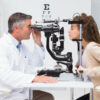
Your Eyes Seem Healthy, But You Should Still Get Them Checked
Do you get your eyes checked annually? Once every two years, maybe? No, not even then? Do you remember the last time you even went in for an eye exam?!
The answer to the last question for the most of us is unfortunately no. A common misconception about eye health is that if there isn’t anything obviously wrong, we don’t need to go to the eye doctor.
However, just because your eyes are seemingly healthy that doesn’t mean that they are. In fact, a lot of common eye conditions can have no symptoms or signs until it is too late to do anything about it. Even if you are taking care of your body with supplements and a healthy diet, absorption of nutrients changes as you age, which is why it’s so important to stay vigilant.
Unfortunately, when we don’t go for an annual eye exam because we think our eyes are healthy, we’re then surprised by severe eye conditions and sometimes diseases that develop.
Glaucoma is an example of a no-symptom eye disease. Most patients only exhibit symptoms and signs of the disease when it has already progressed past the point of curing.
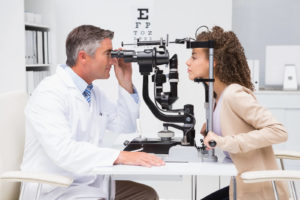 Honestly, you wouldn’t avoid visiting your physician just because you didn’t notice anything wrong with your body this year. We have no way of telling what’s truly brewing beneath the surface unless we seek professional help and advice. The same goes for eye care. Just because your eyes seem healthy, doesn’t always mean they are.
Honestly, you wouldn’t avoid visiting your physician just because you didn’t notice anything wrong with your body this year. We have no way of telling what’s truly brewing beneath the surface unless we seek professional help and advice. The same goes for eye care. Just because your eyes seem healthy, doesn’t always mean they are.
These nasty surprises can be easily avoided. All you need to do is, you guessed it, go see your eye doctor.
When to Get Your Eyes Checked
Knowing when and how often to get your eyes tested is sometimes not an easy thing to ascertain. Do you have to go every year or every two years? Well, the answer isn’t quite as clear cut as that.
All eyes are different and unique. Eyes are so unique that your own two eyes aren’t even the same. That’s why figuring out when to check your eyes really depends on your overall health, your eyes’ health and your individual needs.
Before we get into specifics, let’s talk about your “healthy” eyes. So you think your eyes are healthy. No blurred vision, eye strain, night blindness, etc. Good for you! That probably means you’re doing a great job taking care of your eyes.
You’re probably an avid reader of our blog too, right? Wink, wink.
All right, so healthy eyes all around are great. Maybe your eyes are actually as healthy as you think they are. But even so, eye doctors often recommend having a comprehensive eye exam every two years for adults.
Differentiating Factors
Children and seniors over the age of 60 should get an annual eye exam. This is especially important for children, whose developing eyes are constantly changing, and seniors who are at risk of developing age related eye diseases.
Let’s say you have an existing eye condition or are “at risk.” How often should you see your doctor? The general recommendation is annually or biannually, depending on what condition you have. If you have an existing condition, ask your eye doctor how often you should pay them a visit. They’ll be able to give you a better idea.
You don’t need to have an existing eye condition to be “at risk.” The following factors can make you at risk of developing certain eye conditions and diseases:
- Family history of eye diseases
- Diabetes
- Previous eye injury
- High blood pressure
- Prescription medication with vision altering side effects
A lot of external factors can affect your vision. To be safe, have a dialogue with your eye doctor about how often you should be getting your eyes checked.
Eye Exams: What to Expect
We use the very general terms of getting your eyes “tested” or “checked,” but what does that really entail? Reciting letters off a Snellen chart? Distinguishing different shades of various colors?
See, because the eyes are so complex, there are a number of tests that exist to test every part of the eye. When you go for your comprehensive eye exam, you can expect to have your eyes checked with the seven main tests.
The Seven Main Tests
1. Visual Acuity Test: This is the most common test and the test that is most often featured in film and television. This is the test that uses the aforementioned Snellen test. This will test the sharpness of your vision.
2. Color Blindness Test: This is test is often done at an early age. The most common test is the Ishihara Plates. In this test, the patient is asked to identify the number or shape within the circle.
This tests for red/green color blindness. If colorblindness is detected, a more comprehensive eye screening may be needed to truly know how colorblind the patient is.
3. Ocular Motility Test: An ocular motility test is a fancy way of saying your doctor will be testing your eye movements. This test is simply done by holding your head still (sometimes your doctor may hold your head still for you) and then you’ll be asked to follow a light or an object using your eyes only.
This test, though simple is very important as slow or “jumpy” eye movements can cause eye strain, which can lead to a number of other complications.
4. Cover Test: This is another common test in children, but is also performed on adults on occasion. In this test, your doctor will have you focus on something across the room and then cover one eye. This test assesses how your eyes work independently of each other.
Often this test will detect amblyopia, otherwise known as lazy eye. Lazy eye is a very common, but easily treatable condition in children. Adult amblyopia is not as common and not as easily treatable, but doctors are constantly striving to find a cure for adult lazy eye.
Tests Using Machines
5. Stereopsis Test: A stereopsis test assesses your depth perception. The most common of these tests requires some cool 3D glasses. You will look at a pattern of four circles through these glasses. Then you’ll have to point out which circle looks to be the closest to you.
6. Slit Lamp Exam: This exam is easy, because all you need to do is sit in front of a slit lamp and flash those beautiful eyes of yours. Through the slit lamp, your doctor will study the structure of your eye. The structure of your eye can be quite telling. This test will reveal the presence of cataracts, ulcers, macular degeneration and diabetic retinopathy.
7. Puff-of-air Test: This last test on our list is a test that will measure the intraocular pressure of the eye to test for glaucoma. The technical term for this test is non-contact tonometry, but puff-of-air sounds less scary.
For this test, a machine will send a puff of air into your open eye. Based on your eye’s resistance to the air, your doctor will be able to determine if you are at risk or have begun to develop glaucoma.
As we mentioned before, there are no warning signs for glaucoma, so you’re better off testing it just to be sure. Trust us, the puff-of-air test is painless but glaucoma is not.
Bonus test! Pupil Dilation: This test isn’t always performed during a comprehensive eye exam but it’s still an important one. Using eye drops, your doctor will dilate your pupils to better study the inner structure of the eye. Doctors usually only perform this test when they absolutely need to.
Have we made our point? See your eye doctor at the very least every two years to protect your healthy eyes. Even the healthiest people get sick. But that doesn’t mean there aren’t healthy practices you can put in place to protect your eyes. Prevent eye diseases and conditions by making an appointment with your eye doctor today!
Our Rebuild Your Vision Ocu-Plus Formula Contains All 17 Vitamins, Minerals, and Herbal Supplements to Improve Your Eye Health!






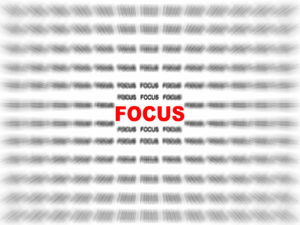
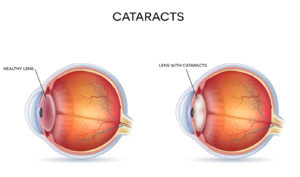
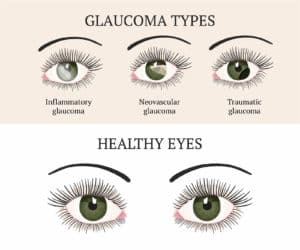

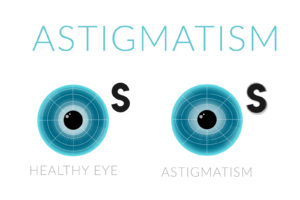
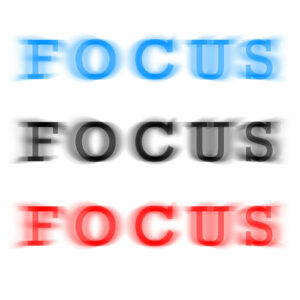
Hi Liz.
You can still do a lot and maybe reverse this insiduous disease. I am in my late fifties, have also struggled with eye problems, am currently finishing my study at the IIN (Institute of Integrative Nutrition) but have been helping people (and dogs) with my health advice for the past 11 years. I would suggest you look into the following:
eating healthily: there are many differing ideas about what is supposed to be healthy. Some ideas are just plain wrong (for example, the recommendation that we should be eating pleanty of “healthy” whole grains, or plenty of fruit – both are namely sugar and sugar does not go well with the eye health). Do not eat grains, and I do not mean just gluten grains. Any food high in carbs is bad news for the eyes. This includes potatoes, corn, rice, wheat, oats, barley, rye, legumes) and all the products made of them, like bread, pasta, pizza, lassagna, not to mentions pastries, biscuits and such.
eating frequent meals: this is also one of the mainstays of “healthy” nutrition, however after each meal, the blood sugar goes up and this unfortunately prevents vitamin C (even if you get enough of it with your food – but that is rarely the case) from entering the cells for the next 4-6 hours. If you eat every 2-3 hours, it is a disaster for the cells, but especially for the eye cells where normally the required leevl of vitamin C is about 200 times higher than in other cells. Reduce your number of meals to 2-3 meals a day (instead of 5-6), to enable vitamin C to have access to your eyes for the most part of the day (and night). You will see the results very quickly.
reducing your eating window: this advice is based on the same facts as the previous one. Instead of having meals for 12 hours per day, narrow the eating time and take food from 6 to 8 hours a day. Sometimes even 4 hours, if you haev for example two meals. Only have main meals, never snack outside the main meals. The meals should be 4 hours apart (when the window is 8 hours), or 4 to 6 hours apart when you have 2 meals.
ensuring you ingest plenty of vitamin C (but without the sugars): the RDA for vitamin C is ridiculously low. I too have some eye problems and am taking about 10 do 15 grams of vitamin C per day. The RDA is 60 mg – almost a thousand times less. You can find your own daily need by doing the Vitamin C tolerance test (find this on the Internet). Take it as a supplement (and make sure to always accompany it wth bioflavonoids because that is how it works much better and you will need less). Take it with meals and outside the meals, because it functions differently in these two cases. Do not drink orange juice, it is a very poor surce of vitamin C (even if you press is freshly yourself) but i s at the same time full of sugar! Do not drink bought fruis juices, orange or other, especially not if they are pasteurized
Avoid all pasteurized (or homogenized) food but drink raw milk if you can get it and if you like it (and you are not intolerant). It is a great source of raw protein that our body needs. If raw milk does not agree with you, try fermented raw milk that you ferment at home. Just pour 1 liter of raw milk in 5 cups (200 ml each) and leave them on the countertop for a few dys, and you will have 5 delicious (nd non-expensive) meals of raw sour milk. Food quality is (almost) more important than what kind of food you eat.
Avoid all processed, bleached “whte” plant oils (that are being touted as healthy). They are proinflammatory, which is very bad for your condition) and totally carcinogenic. These are the oils like soy, corn. canola, sunflower etc.
Try to choose organic foods as much as you can. It is more expensive but eyesight is priceless. Find the Dirty Dozen on the Internet and avoid them like plague, but do eat the Clean Fifteen (these are 15 foods that can be eaten even if not organic because there s not much pesticide residue in them.
Raise your magnesium and vitamin D3 levels by supplementation.
Eat low glycaemic foods. And just stop eating sweetes and baked good. Desserts are not good for the eyes, even if they are raw, organic, hand made and God knows what. I see so many thimes recommendations to make desserts with maple syrup, agave syrup, turbinado sugar, raw Medjool dates, dried figs etc. All this is death for the eyes! And so is dried fruit which is up to 80% sugar!
Also, I must not forget:
Take a good quality eyes upplement like Tyler’s. At our age, just food is not enough because it is often not fresh and lacks the vital nutrients because they are unfortunately not present in the soil anymore.
I have had eye problems for most of my adult life and I have eye check ups every few months. However, I still developed glaucoma whilst in my 40’s and more recently – advanced glaucoma which continues to destroy more of my retinal cells. The point I’m making is that even with regular check ups and surgery and eyedrops glaucoma can still rob you of your sight. I would also like to add that I am now in my early 50’s and have always eaten healthily, exercised regularly and never smoked.